(Gray whale, Magdalena Bay, Mexico)
We visited Mexico's Magdalena Bay after a relaxing and fun-filled stay on Isla Espiritu Santo, driving north and west from La Paz the Baja peninsula towards the Pacific Ocean.
The countryside is desert and the vegetation not unlike what you’d find in Arizona or parts of Southern California. Within 4 hours we reach the shores of the Bay. Our crew loads the skiffs and we make our way across to the northeast shore. The huge bay, 50 km long, teems with bird life, especially pelicans and gulls. It has a distant outlet to the Pacific, its waters are fairly calm, sheltered by two large islands; it’s clear why Magdalena Bay would appeal to mother whales with young calves.
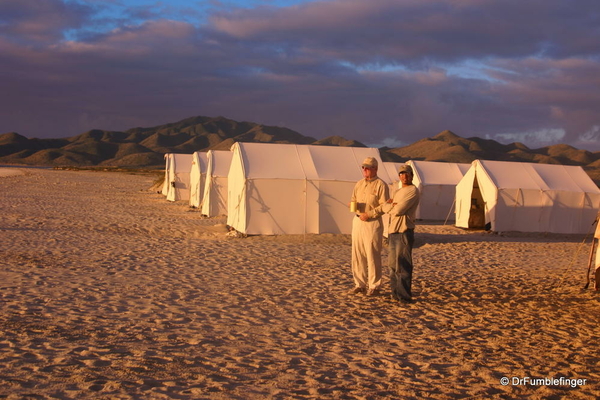 (Enjoying the sunset by our sleeping tents, Magdalena Bay)
(Enjoying the sunset by our sleeping tents, Magdalena Bay)
Our camp has a nice setup, not unlike a M*A*S*H unit — rows of sleeping tents, a cooking tent and a large dining tent — and will be our home for 3 nights. The campsite is “primitive” but not uncomfortable, and the views over the bay and great sunsets make it well worthwhile. Our staff treats us like royalty, the cook whipping up some great meals like fresh grilled fish, great guacamole, tasty soups and marlin tacos (best tacos I ever had!)
Our prime purpose here is to go whale watching but there are other opportunities for recreation like a chance to kayak, beach-walk, hike, fish, play beach volleyball or just relax. I enjoyed a 3 hour stroll on the beach one day never encountering another person. The weather is mostly warm and pleasant but it’s much windier and cooler than on the Sea of Cortez, especially after sunset.
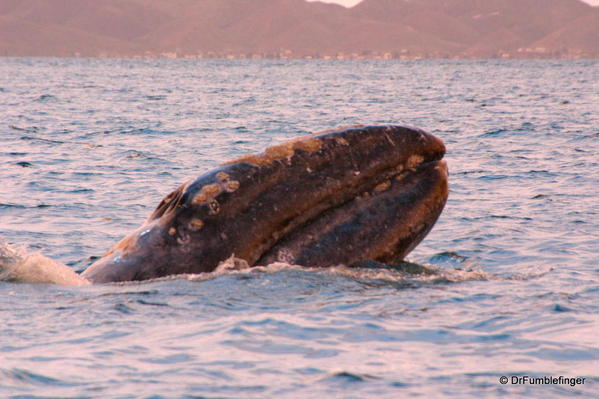 (Gray whale calf, Magdalena Bay)
(Gray whale calf, Magdalena Bay)
Gray whales complete one of the most impressive annual migrations of any animal in the world, traveling about 7,000 kilometers each way between Mexico and Alaska. They’re baleen feeders and their summers are spent feasting in the plankton rich waters off Alaska where they put on a thick layer of blubber. As winter takes hold, the whales migrate south for 8 weeks to several bays off Mexico’s Baja coast, including Magdalena Bay (some juveniles even head around the tip of the Baja peninsula into the Sea of Cortez). In the bays they mate and then a year later the females give birth.
A few months after arriving in Baja, usually at the end of February or early March, the whales begin their migration back to Alaska. The last to join this migration are females and their young calves, allowing the calves slightly more time to grow and build strength for the long journey. It’s very common to see the whales on their migration from the shore off the west coast of Mexico, the USA and Canada.
It’s during this migration that the babies are vulnerable for the last time in their lives. Orcas are known to hunt them and will pursue these mother-calf pairs for hours. The mothers defend their calves as best as they can but really stand no chance against a pod of killer whales (they themselves are not targeted by the orca’s coordinated attack, only the calf is). After killing a gray whale calf, the orcas usually only eat its tongue, apparently a choice morsel, letting the rest sink. Gray whales were once endangered but are a conservation success story; it’s estimated that over 20,000 now survive off North America’s Pacific coast.
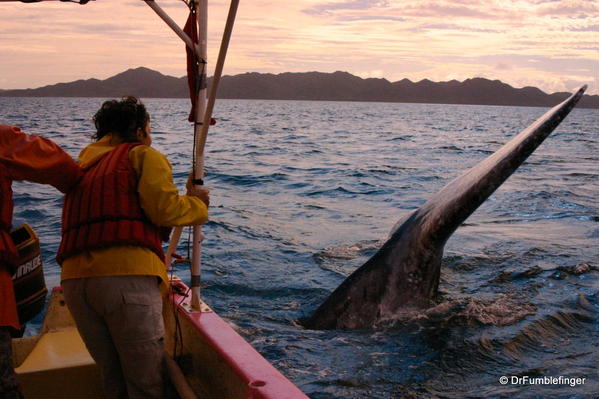 (Gray whale diving under our boat, Magdalena Bay)
(Gray whale diving under our boat, Magdalena Bay)
Gray whales begin their life quite large, weighing a half ton and measuring over 4 m at birth. Their mother’s rich milk (more than 50% fat) helps them grow quickly and prepares them for their journey north . As adults they grow to 15 m (50 ft) in length and weigh up to 20 tons. It’s hard to really appreciate how large they are until you see them up close.
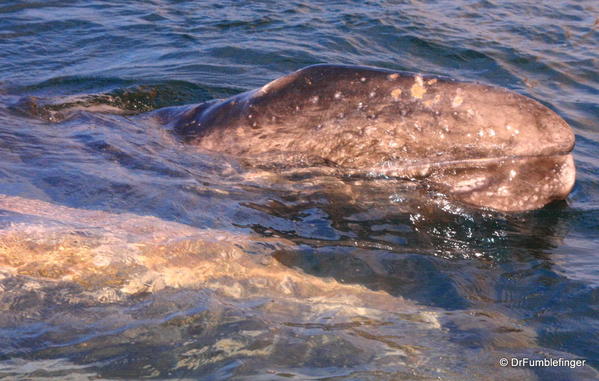 (Gray whale and calf, Magdalena Bay)
(Gray whale and calf, Magdalena Bay)
Close encounters….
We spend 3 days on the motorized skiffs (known as pangas), usually going whale watching twice a day after breakfast and again in the afternoon. We see large numbers of whales and learn to spot them by the “blow” of mist they exhale, often at a great distance (the same trick old whalers used). We see them swim and dive, and find large numbers of mother-calf pairs. On the last day, one of these mother-calf pairs approaches our panga and begins to interact with us (such whales are known as “friendlies").
The whales are gentle in their approach and allow themselves to be touched. They rub against our hands, the side and bottom of the boats, and again I’m amazed at how careful and gentle they are. They could easily flip our boat if they wanted. It’s unforgettable to be so closely approached by one of nature’s largest creatures and leaves me with one of the most memorable travel experiences I’ve ever had! This interaction is the climax of the trip and comes at a good time. The next day we return to La Paz and ready ourselves for our flights home, but not without some truly great memories!
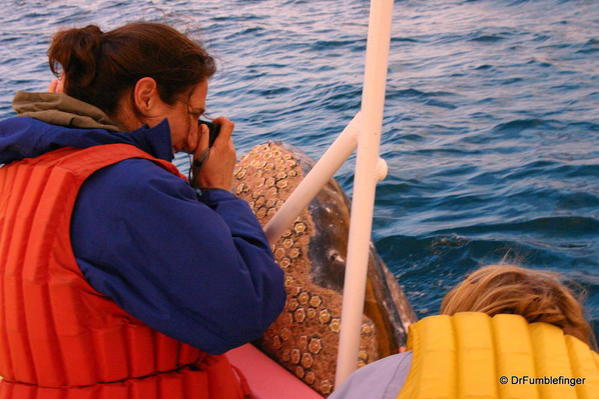 (Close encounter with a gray whale, Magdalena Bay)
(Close encounter with a gray whale, Magdalena Bay)
An earlier version of this blog appeared in 2013, before TravelGumbo's official opening.

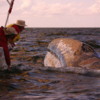





Comments (1)